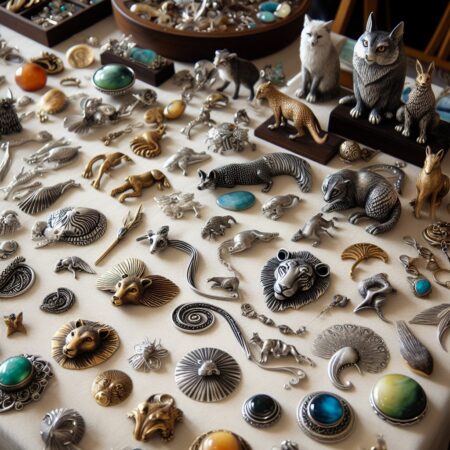Mystical symbols and meanings abound. They surround us and pepper art, music, history, and culture. You can also find mystical symbols and meanings in various crafts and art forms, including modern jewelry and DIY jewelry. You can explore a variety of symbols in Xinar’s many charm collections, like our Celtic Wiccan belief charmsand our medals, talismans, and amulets. Take magic along with you wherever you go- shop Xinar today!
Birds
Generally speaking, birds’ mystical symbols and meanings revolve around abstract concepts like love and independence. However, as a symbol of boundless potential and infinite flight, the bird has long been used to represent the mind. As a result, many people associate birds with certain feelings.
Birds are commonly used as symbols of community, family, parenting, and romance due to their innate tendency to form strong bonds with their mates and devote much attention to raising their young. Parent birds represent guardianship and protection, while young birds represent naiveté and youth. Birds’ nests represent houses.
Birds, in general, and certain birds have inspired several idioms and superstitions. For example, many people have heard the expressions “killing two birds with one stone” or “a bird in the hand is worth two in the bush.” In these expressions, birds have wildly divergent meanings.
Popular bird icons include the following: crow, bluebird, cardinal, falcon, hummingbird, nightingale, peacock, sparrow, swan, owl, eagle, and crane.
Ankh
Ancient Egyptians adopted the cross-shaped symbol of the Ankh to symbolize the concept of life in their writings. By extension, this cross became a symbol of life primarily. Because ancient Egyptians believed that death was merely a gateway to the afterlife and eternal life, this cross was also placed on the lips of deceased kings. The rich history of the Ankh makes it a logical part of our list of mystical symbols and meanings.
As with many symbols with a spiritual or religious background, this one does not have a singular interpretation.
This symbol, and variants thereof, have been used by various cultures and religions throughout history, each of which has assigned it a unique significance.
The Egyptians primarily viewed it as a symbol of longevity or immortality. In this way, too, it was connected to the afterlife and funeral rituals.
As such, the Ankh has also come to represent harmony in the face of adversity, such as the harmony of masculinity and femininity. It can also stand for joy, vitality, and procreation.
The symbol’s meaning has been interpreted in various ways, but one interpretation links it to sexual union and, by extension, fertility, and life. This allows us to interpret this symbol as a symbol of eternal life and present existence.
Some have suggested that the cross’s upper part, the handle, represents the uterus, symbolizing the rapprochement of opposites, unity between the males and females, and most importantly, procreation and, by extension, the rest of life.
Flowers, Leaves, and Plant Life
Plants serve as symbols in many different folk traditions and cultures. Some of their original meanings persist, even though they are rarely used in today’s urbanized society. There are also allusions to these interpretations in classical art, music, and literature. There has also been the emergence of new symbols, the most well-known of which in the United Kingdom is the red poppy, which is worn to honor the sacrifices of military personnel who have died in service.
Over several centuries, the language of flowers has been widely accepted in numerous European and Asian nations. They are so crucial that even Shakespeare uses them frequently in his plays. There’s a reason why flowers and plants are so frequently used as symbols in ancient Chinese, Egyptian, Roman, and Greek plays, sonnets, folktales, and mythologies.
Whether you’re celebrating Mother’s Day, a friend’s birthday, or Valentine’s Day, flowers are the perfect way to show how much you care. For instance, the orange blossom symbolizes innocence, purity, and beauty, while the red chrysanthemum expresses undying love.
Popular flower and plant-related icons include the hibiscus, pine cone, maple leaf, shamrock, and acorn.
Dragons
Last on our list of mystical symbols and meanings is the dragon. The dragon combines the serpent and the bird, each of which carries significant meaning, symbolizing great complexity. Between the two of them, they make for one of the most formidable monsters in history. In both medieval and Christian cultures, the dragon represents all that is dark and evil.
It represents supernatural strength, wisdom, and knowledge in the Orient. Across cultures, it represents the uncontrollable forces of nature and disorder. It conjures images of lofty mountains, ominous clouds, and the ocean’s uncharted depths. Legendary heroes must often confront and defeat (or “slay”) dragons to seize control of a region or a vital treasure. Slaying the dragon symbolizes the battle between good and evil, the triumph of light over darkness.
Psychically, it’s the apprehension of incest; spiritually, it’s the chaos of the unconscious; and morally, it’s evil. This name refers to the primordial matter in alchemy. It is a protector of life in Yeats’s poetry, but it represents sex and war in Blake’s. Weapons dipped in dragon blood are a talisman that brings prosperity, health, and luck, but they also cause permanent damage if used on a living being.
Throughout history, dragons have been used to symbolize the ultimate beast, the enemy, and the devil in both Western and Eastern cultures.
Besides representing danger, the dragon can also represent sin, evil, water, clouds, rain, and floods. The Hebrews believed it to be a monstrous creature lurking in the ocean’s depths.
In Chinese folklore, this fantastic beast became a prehistoric Yangtze River monster. So majestic was the beast that it has to be part of our list of mystical symbols and meanings. The crocodile was linked to the dragon in Egyptian mythology. It also symbolized the elements of water, clouds, rain, floods, and sin. The dragon’s gaping maw, spitting flames, came to symbolize the “jaws of hell” in Christian art—many cultures associate dragons with the element of fire and, by extension, with desire. There is a solid spiritual connotation to the dragon in China. It was associated with water, which can be beneficial and destructive in the form of floods. The legend of the dragon’s ability to bestow rain and the favor of the Rain Gods soon became synonymous.






